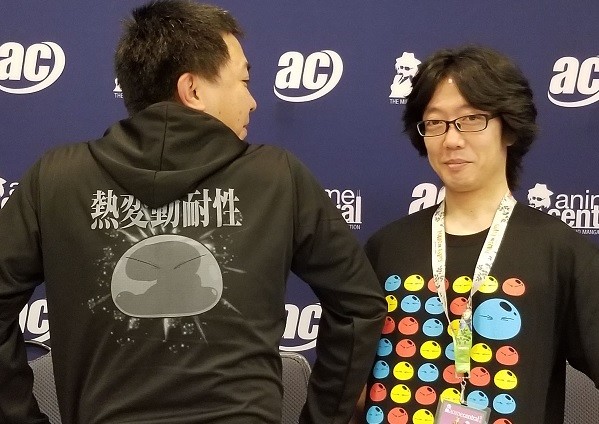Interview: The Cast and Crew of That Time I Got Reincarnated As A Slime
by Theron Martin,
The anime adaptation of That Time I Got Reincarnated as a Slime became quite popular during its run in the Fall 2018 and Winter 2019 TV seasons, enough so that Crunchyroll had part of its industry booth specifically devoted to an interactive feature involving it at this year's edition of Anime Central. Among the convention's guest this year were members of the series' staff and cast. Anime News Network was given the opportunity to interview three of them: Assistant Director Atsushi Nakayama (on the right in the photo), Character Designer Ryōma Ebata (on the left), and seiyuu Miho Okasaki, who voiced Rimiru. (Okasaki had to leave early and so could not be included in the photo.)
ANN: For Okasaki-san, in the anime Rimiru has a very distinctive vocal style. I can't think of any other role that it much resembles. Where did you get your inspiration for this voice?
MIHO OKASAKI: When I was auditioning for the role, I saw the character design, and sometimes I just come by with straight instinct what the proper vocalization for a character might be, and this was the case here.
This was, I believe, only your second major role and first leading role. What has your experience been in dealing with the increased fan attention?
OKASAKI: I'm very happy that all the people who didn't know me got to know me as a voice actor through the series.
Were there any scenes that you particularly enjoyed voicing?
OKASAKI: It's very difficult to answer. That would be the establishment with the elves, where Rimiru gets to the see the ladies there. It's not the kind of role that I get to often, so it was fun to do.
(Miho Okasaki had to leave at this point.)
For Nakayama-san and Ebata-san, at the time you signed on to the series, what was your level of familiarity with the source novels and/or manga version?
RYOUMA EBATA: For me, I read all of the original web version that became the novels. I hadn't read any of the manga version.
ATSUSHI NAKAYAMA: For me, I only knew about the title, and that it was a popular title from the web site. So that's where I started.
For Nakayama-san, you are listed in our site's Encyclopedia as both the Assistant Director and an Episode Director. Can you clarify your responsibilities in each role?
NAKAYAMA: My role as Assistant Director was to be with the director [Yasuhito] Kikuchi and participate in production meetings and also work with the plot development. Director Kikuchi mostly had the task of working on the screenplay and storyboard phase. Most of my Assistant Director work involved the photography and final delivery of the film. As Episode/Technical Director I worked on episode 1 and some of the key episodes. Most Episode Directors would not be worried about what happens in the continuity of the following episodes, but since I was also Assistant Director, I took notes about what to do with the continuity as well.
Also for Nakayama-san, you have served as Episode Director numerous times over the past 20 years. In your experience, has there been any major change to that role over time?
NAKAYAMA: The biggest change in my 20 years was the production going from analog to digital. This was taking place about 15-20 years ago. Before getting into anime I worked in the video game field with a lot of CG works, so I actually went into the industry selling myself as someone very versed in digital production.
For Ebata-san, how much interaction, if any, did you have with light novel illustrator Mitz Vah or manga-ka Taiki Kawakami about the character design process?
EBATA: At the very beginning, when I still had a blank sheet, I had a meeting with both to set the direction for the anime. Mitz Vah's illustrations have a unique touch among light novel illustrations, so there was a lot of that taste that I wanted to retain for the anime. Also, Kawakami has a very refined style in the manga version, so I wanted to take the best of both styles and incorporate that into the anime.
Also for Ebata-san, you are listed as being heavily involved in creating the openers and closers for the series. How much autonomy did you have in designing them, and how did you balance selling the series vs. providing spoilers?
EBATA: When I get to work on the opener or closer, I have complete freedom as to what to do. As for how much of a spoiler vs. a sell, I start by receiving the songs for the opener and closer, and I would listen to them for three continuous days until I get an inspiration for what to do. So listen for three days, get inspiration, that was my style.
My last question for both: Do you have a favorite episode or scene from the anime version?
NAKAYAMA: For me, that would be episode 1, right after Rimiru has been freshly-reincarnated and has no name yet. You see Rimiru in slime form the most in episode 1 and 2, so that's when I can get the animators to be as free as they want to do “lightly slime” animation. So I am fond of these episodes.
EBATA: For me, Rimiru, in order to obtain human form, must capture a human, and that happens with the capture of Shizu. Shizu gives her life in order for Rimiru to obtain human form, and that's my favorite scene.
Mmm. I think a lot of fans would agree with that.
discuss this in the forum (3 posts) |
this article has been modified since it was originally posted; see change history